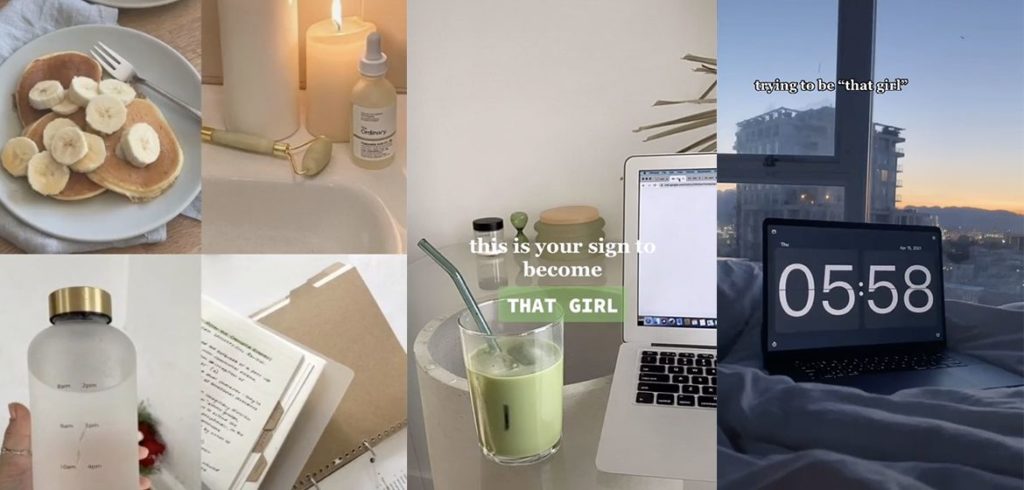by Elisa Redza

THE ENDLESS SCROLL
“…I remember seeing that picture and realizing that photographs weren’t real. There’s no context, just the illusion that you’re showing a snapshot of a life, but life isn’t snapshots, it’s fluid. So photos are like fictions. I loved that about them. Everyone thinks photography is truth, but it’s just a very convincing lie.” – V. E. Schwab, The Invisible Life of Addie LaRue
Social media is like a gallery of sorts. A curated feed of images, sometimes videos, so you don’t have to go searching for the right one.
People document their lives and share them online.
Aesthetics are important and trends come and go.
Algorithms promote specific content and narratives are constructed..
Comparisons come easy and sometimes I feel inadequate.
THAT GIRL
She’s living her best life and so can you.
‘How to be that girl’ is a trend that originated on TikTok, and is all about being the best version of yourself. Creators document their daily routines in hopes of inspiring others to ‘take this as a sign to be that girl’ and start treating themselves better. Common habits in these videos include but are not exclusive to, waking up early, journaling, eating healthy, exercising, and getting work done.

Despite being well-intentioned, the trend has sparked some controversy. On one end of the spectrum, people are voicing out their concerns over the lack of diversity in ‘that girl’ content. Coupled with its inherent virality, this has the potential to create the narrative that what is portrayed is the best and the only way to live. After watching compilations of ‘How to be that girl’ TikToks, there is undoubtedly a prominent theme. Most, if not all of the TikToks, include a nicely decorated room in the background, pretty tableware, and popular skincare products. Many of these items aren’t easily accessible to people and are thus considered a luxury. When this image of life comes across as the ideal, it may lead to people setting unrealistic standards for their life. Additionally, it showcases class disparity as it is only attainable for the privileged; it’s based on the assumption of having financial security which isn’t the case for the majority of people. By contributing to feelings of dissatisfaction, people are encouraged to seek out temporary solutions in the form of consumerism.
However, a number of people believe that the trend has been wrongly interpreted. Supporters of the ‘that girl’ trend explain that they don’t feel any pressure to mimic the lifestyle, instead, they feel motivated to kickstart their own version of a productive and healthy life. The original meaning of ‘becoming that girl’ was to become the best version of yourself—therefore, ‘that girl’ will look different for everyone. YouTubers who’ve tried out the trend will make adjustments respective to their personal circumstances; for example, instead of forcing themselves to wake up at 5:00 am, which most TikToks show, they’d start their morning at 7:00 am. Some have even seen it as a challenge to incorporate new habits like journaling or exercising into their daily routines to see if it’s for them. The question is: if ‘that girl’ is a subjective concept, how could it pressure people to conform to a single narrative?
‘That girl’ walks a fine line between being an aesthetic and being a lifestyle, which is why it sets itself as being an example of performative behavior. As part of the trend is to take pictures of your day, a person can easily manipulate others’ perception of their life by choosing to only include ‘aesthetic’ pictures. Its effortlessness is crafted meticulously; getting the right angles to make your food look more appetizing, or catching the right light to make your room look nicer. Without asking how or if they could benefit from the habits shown in the videos, people may be setting themselves up for disappointment and comparison. If a person were to exercise simply so that they could post pictures of their workout with the intention of showing others that they’re getting their life back on track, then they wouldn’t be partaking in the ‘that girl’ lifestyle because it’s all about substantially improving yourself for yourself.
WORKING HARD OR HARDLY WORKING?
Productivity has been the face of the ideal lifestyle for many years. There are countless articles, interviews, and YouTube videos circulating the internet on how to improve your productivity or how to be productive when you’re feeling unmotivated. Glow-up challenges often include finally getting a to-do list done as part of getting your life back together. The ‘that girl’ trend is largely based on these challenges—the trend repackages activities characteristic of glow-up challenges to be less intimidating by advertising the change in lifestyle to be gradual instead of instantaneous. Time and time again we are being sold the narrative that our best self is our most productive self.
By now, most of us have acquainted ourselves with some form of a reward system, a method often used to start one’s productivity—if you complete a task, then you are entitled to treat yourself. In the long run, this method could affect our perception of self-worth and love. If you only see yourself as worthy of relaxing after getting a task done, then do you really love yourself unconditionally?
For a long time, productivity was seen as getting work done, in recent years we’ve redefined productivity to being intentional with how you’re spending your time. So, activities aimed at the individual like cleaning, baking, and reading are now considered productive. While this development encourages people to reevaluate how they define their actions in a positive manner, it does have its consequences.
Behold, the ‘Goodreads Reading Challenge’ phenomenon. If you’re an avid reader like myself, then you’re probably familiar with it. The challenge allows a user to select a number of books they’d like to read in a year. Users can see what others have set as their goals and how far they’ve gotten along. Even though the feature was added to help track your progress, for some it has ruined the reading experience; the presence of a challenge pressures them to constantly read or read multiple books at a time in order to not fall behind.
It begs the question: “Am I reading…the list?”
Performative behavior has made room for itself in how we see ourselves in relation to productivity. During exam season, it’s usual for people to post about their late-night study sessions or their progress on an assignment on Instagram. You could do this for a number of reasons: motivating others to keep going, keeping yourself accountable by sharing your goals, or maybe it’s because you don’t feel productive until others know about it. Maybe I’m just calling myself out here, but it’s a real possibility—it certainly feels good to be able to tell someone that you wrote four essays today and even outlined the fifth one.
At what point did we start placing our happiness in the amount we can produce, whether it be how many books we read or past year papers we complete?
YOUR BEST LIFE
“You can choose choices but not outcomes.” – Matt Haig, The Midnight Library
As we migrate more of our lives online and create new personas, it becomes hard to differentiate between what acts are for yourself and which are for others; blurring the line between realities.
Spending so much time exposed to other ideas allows you to be influenced. While this is not inherently bad, it’s important to reflect and cultivate your own opinion. We’re beginning to see a shift in which more and more people are discussing the extreme or negative effects of social media and how algorithms work in ways to create an over-imposing narrative.
The “that girl” trend, in my opinion, should be renamed as the name implies comparing yourself to another person or an external version of yourself. The culture of self-optimization depends on one’s need to continuously shift the goalpost. If there is no definite end goal, and if the “that girl” concept is subjective and ever-changing, then burnout is inevitable. Seeking your self-worth in things or concepts external to yourself is a recipe for disaster because that feeling of fulfillment will only be temporary—it is inanimate, and hence it is physically unable to give you the sense of security you’re seeking. Ultimately, your best life is one that is lived entirely for yourself, one where you lift off the pressure of performing for everyone else.